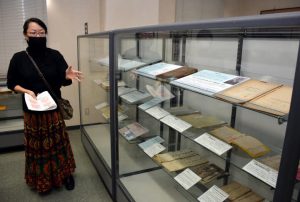Exhibit of 150 items in A-bombed building museum traces Hiroshima’s medical history
Feb. 25, 2022
by Kyosuke Mizukawa, Staff Writer
A special exhibit titled “Red-brick Institute of Medicine” is now being held at the Hiroshima University Institute of History of Medicine, an A-bombed structure located at Kasumi 1-chome in Hiroshima’s Minami Ward. On display are some 150 materials related to medical care provided in pre-war Hiroshima, as well as medical care designed for the treatment of A-bomb survivors. The exhibit, organized by Hiroshima University’s Research Institute for Radiation Biology and Medicine (RIRBM), will continue through March 23.
Main among the items shown for the first time are those donated by the late Kanzo Ohashi, a physician whose family had practiced medicine for generations in the present-day Niho area of Minami Ward. One is a daily record of patient names written during the Meiji Era (1868–1912) of Japanese history. Another is a record of drug purchases during the Taisho Era (1912–1926). Such materials reveal the state of medical care in Hiroshima before the war.
Also on display is a handbook regarding the Atomic Bomb Medical Relief Law published by Japan’s former Health and Welfare Ministry. The handbook was used by the late Dr. Yoshimasa Matsuzaka, who experienced the atomic bombing and devoted his life to the health care of A-bomb survivors. One of the exhibit panels explains how the current institute was repaired using bricks from a building used during the war as Arsenal No. 11 of the Hiroshima Army Ordnance Supply Depot.
Many of the institute’s permanent exhibits have been removed from the exhibit room and are now undergoing maintenance to eliminate dust and insect pests. The space vacated in this way is now being used for the special exhibit. Akiko Kubota, assistant professor at the analysis section of the RIRBM’s Division of Radiation Information Registry, said, “I hope visitors will learn not only about medical care related to the atomic bombing but also about the history of medicine in the local area.” Admission is free. The exhibit is open between 10:00 a.m. and 4:00 p.m. every weekday. Reservations, which can be made on the RIRBM website, are required. For more information, call the RIRBM analysis section at 082-257-5877.
(Originally published on February 25, 2022)
A special exhibit titled “Red-brick Institute of Medicine” is now being held at the Hiroshima University Institute of History of Medicine, an A-bombed structure located at Kasumi 1-chome in Hiroshima’s Minami Ward. On display are some 150 materials related to medical care provided in pre-war Hiroshima, as well as medical care designed for the treatment of A-bomb survivors. The exhibit, organized by Hiroshima University’s Research Institute for Radiation Biology and Medicine (RIRBM), will continue through March 23.
Main among the items shown for the first time are those donated by the late Kanzo Ohashi, a physician whose family had practiced medicine for generations in the present-day Niho area of Minami Ward. One is a daily record of patient names written during the Meiji Era (1868–1912) of Japanese history. Another is a record of drug purchases during the Taisho Era (1912–1926). Such materials reveal the state of medical care in Hiroshima before the war.
Also on display is a handbook regarding the Atomic Bomb Medical Relief Law published by Japan’s former Health and Welfare Ministry. The handbook was used by the late Dr. Yoshimasa Matsuzaka, who experienced the atomic bombing and devoted his life to the health care of A-bomb survivors. One of the exhibit panels explains how the current institute was repaired using bricks from a building used during the war as Arsenal No. 11 of the Hiroshima Army Ordnance Supply Depot.
Many of the institute’s permanent exhibits have been removed from the exhibit room and are now undergoing maintenance to eliminate dust and insect pests. The space vacated in this way is now being used for the special exhibit. Akiko Kubota, assistant professor at the analysis section of the RIRBM’s Division of Radiation Information Registry, said, “I hope visitors will learn not only about medical care related to the atomic bombing but also about the history of medicine in the local area.” Admission is free. The exhibit is open between 10:00 a.m. and 4:00 p.m. every weekday. Reservations, which can be made on the RIRBM website, are required. For more information, call the RIRBM analysis section at 082-257-5877.
(Originally published on February 25, 2022)








